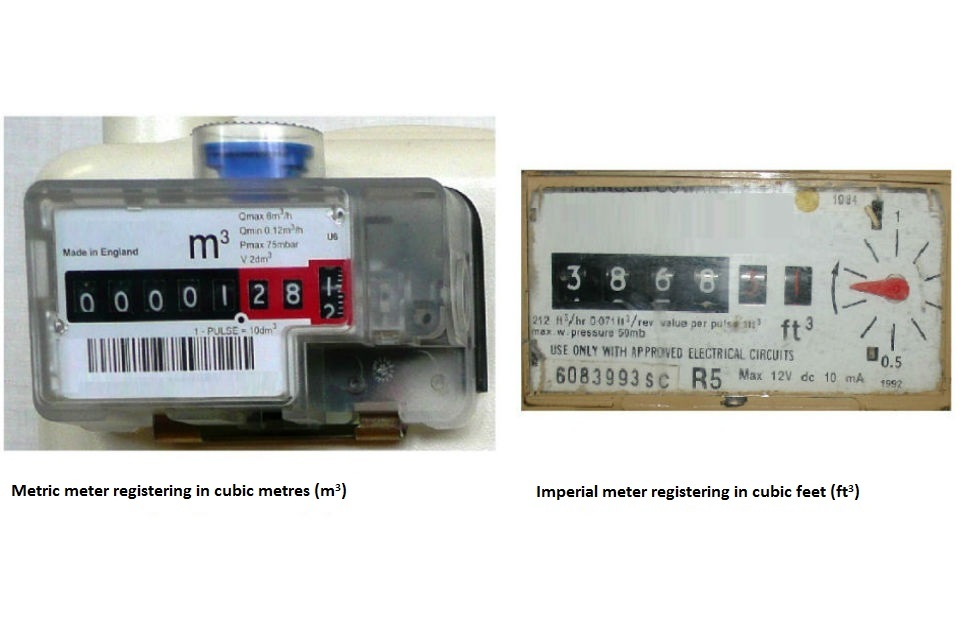Gas meter readings and bill calculation
How to read your gas meter and convert this reading to kilowatt hours.
Gas bill calculations
Gas meters generally record the volume of gas consumed in cubic feet (ft³) or cubic metres (m³) although consumers are billed in kilowatt hours (kWh). The calculations used to generate gas bills are prescribed in:
The Gas (Calculation of Thermal Energy) Regulations 1996 (SI 1996/439)
The Office of Gas and Electricity Markets (Ofgem) is the energy regulator and has responsibility for these regulations.
The following steps explain how to read your gas meter (imperial or metric) and convert this reading to kilowatt hours. However, the Office for Product Safety and Standards is only responsible for gas meter accuracy and complaints about billing should firstly be directed to the supplier concerned. The Citizens Advice consumer service can assist you with this and provide independent advice on energy supply. If your supplier is unable to resolve your dispute then the Energy Ombudsman can investigate.
Metric or imperial
Although all new gas meters register in cubic metres, a significant number of imperial gas meters (registering in cubic feet) are still used for billing consumers. The approval process for gas meters requires the unit of measurement to be clearly marked on the register of the meter; for example:

A metric gas meter registers in cubic meters while an imperial gas meter registers in cubic feet.
With a metric meter the part units of gas are highlighted in red and those digits are often separated by (i.e. to the right hand side of) a decimal point. With an imperial meter the part units are often displayed in the form of a dial as illustrated above. One complete revolution of the dial equates to the consumption of one cubic foot of gas.
Providing meter readings
Your gas supplier should take regular readings of your meter. If your supplier is unable to do this for any reason then you may want to take the reading yourself and provide this to the supplier. Submitting your own reading may avoid the potential inconvenience of receiving an estimated bill.
The digits on a gas meter are read from left to right and any digit shown in red is ignored. It is important however that any ‘zero’s’ are included in the reading provided to the supplier thus in the following examples:

The reading on the metric meter has eight digits, the first five of which are in black. The reading on the imperial meter has six digits, the first four of which are in black. Only the black numbers are used for a reading to the supplier.
Calculation of gas bill
Information found on the gas bill itself will generally explain how the bill has been calculated. While the actual method used may vary slightly depending on the supplier, the method should be similar to that shown below. All conversion factors are prescribed in the Gas (Calculation of Thermal Energy) Regulations 1996 (SI 1996/439).
Step 1
Subtract your previous reading from your current reading to give the number of units used over the billing period.
Step 2
The conversion factor from cubic feet to cubic metres is 0.0283 therefore:
- 1 cubic foot = 0.0283 cubic metres
- 100 cubic feet = 2.83 cubic metres
For imperial meters the reading (in hundreds of cubic feet) is therefore multiplied by 2.83 to convert to cubic metres (if the reading to the supplier was provided in cubic feet then this should be multiplied by 0.0283). This step is not required for metric meters as they are read directly in cubic metres.
Step 3
This figure is then multiplied by the calorific value of the gas which is a measure of the available heat energy. Calorific values vary and the figure quoted on your bill (eg 39.5 megajoules per cubic metre (MJ/m³)) will be an average of the gas supplied to your property (the regulations explain how this is calculated). Gas transporters are required to maintain this figure within 38 MJ/m³ to 41 MJ/m³ as figures outside of this range will cause problems with gas burning appliances.
Step 4
The figure is then multiplied by 1.02264 as prescribed in the above regulations. This corrects the volume of gas to account for temperature and pressure (as gas expands and contracts).
Step 5
Finally the figure is converted to kWh by dividing by 3.6. Again, this factor is prescribed in the above regulations.
Step 6
The number of kWh is then be multiplied by the price per kilowatt hour as detailed on your gas bill. You may also have a standing charge or one price for the first ‘X’ number of units and a lower price for the remaining units.
Further Information
Questions about reading your gas meter or complaints about billing should firstly be directed to the supplier concerned. The Citizens Advice consumer service can assist you with this and provide independent advice on energy supply. If your supplier is unable to resolve your dispute then the Energy Ombudsman can investigate.